Analysis of Economics of US Bamboo Industry
Who Will Buy Your Poles?
Most people who consider farming bamboo for profit, assume that they will make their money from selling poles. Who will they sell to? There is no US industry that buys and processes bamboo poles. There is a huge US industry to buy and process trees. Recently I drove two hours west toward Columbus, GA, from my Bamboo Farm in Hawkinsville, Georgia. For the first hour, I was on gentle land with crop fields and pecan orchards. For the second hour, I was on rolling hills too steep for agriculture. I drove through pine plantations, not wild forests, planted pines. It struck me how large the tree based lumber industry is. Thousands and thousands of acres support the industry. The industry goes from tree planting, to harvesting, to manufacturing and distribution – and replanting with specialty grown seedlings. There is nothing like that for bamboo.
Trees for lumber are easy to grow compared to bamboo. Plant the seedlings and with minimal care, in 15 and 25 years you have a harvestable crop of logs. Not so with bamboo. It needs yearly thinning, irrigation, weed control.
Bamboo not a forestry crop; it is an agricultural crop. Bamboo needs annual care at least.
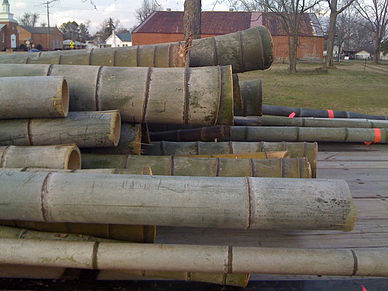 While the first problem with selling bamboo poles is “Who-will-Buy-Them?”, the second problem is that China exports bamboo poles. The poles are clean, straight, uniform in size, smooth, cheap and bundled impeccably. You can order different lengths and different diameters.
While the first problem with selling bamboo poles is “Who-will-Buy-Them?”, the second problem is that China exports bamboo poles. The poles are clean, straight, uniform in size, smooth, cheap and bundled impeccably. You can order different lengths and different diameters.
Bamboo nurseries make much of their income by installing and maintaining bamboo hedges for one customer, and, by removing run-away bamboo from another. Usually, they chip the poles removed at the work site. The bamboo chips are either spread back into the grove as mulch or trucked to the nursery to pave pathways and/or to sell as mulch. If the grove has some good poles, the crew brings them back to the nursery to clean, display and sell.
There are US businesses selling US grown poles. Brightside Bamboo, a bamboo nursery in North Carolina, sells poles harvested while doing grove and hedge maintenance. Brightside prices poles according to length and diameter. Big Bamboo, owned by Ray and Travis Peavey sells poles harvested from selected groves throughout the State of Georgia. Big Bamboo only cuts poles when they have an order. They don’t stock poles in a warehouse. Their market is the movie industry. A specialty buyer! Another bamboo business Blackwood Bamboo removes unwanted bamboo; brings the poles to the shop; makes charcoal; sells the charcoal to State campgrounds. Campers love the way bamboo charcoal burns.
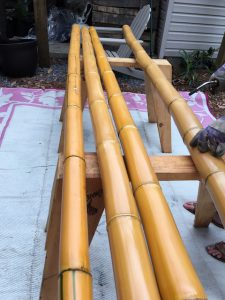 It takes time (labor) to cut poles to sellable lengths, pressure wash them, and torch them to bring out the natural oils. The photo to left shows the color of golden vivax poles after torching. These poles will fade to a light golden tan. The vivax poles are thin walled so make fine cups and dishes. As poles they will crack. Big Bamboo (Ray Peavey) kiln dries his poles at high temperatures. They do not crack. They have bright colored skins.
It takes time (labor) to cut poles to sellable lengths, pressure wash them, and torch them to bring out the natural oils. The photo to left shows the color of golden vivax poles after torching. These poles will fade to a light golden tan. The vivax poles are thin walled so make fine cups and dishes. As poles they will crack. Big Bamboo (Ray Peavey) kiln dries his poles at high temperatures. They do not crack. They have bright colored skins.
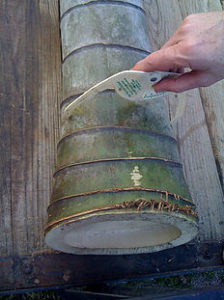
While you can harvest poles from your mature groves, you can not find industrial scale buyers like lumber mills. National Bamboo is working to change that. An industry that uses bamboo poles has been lacking since the USDA began introducing bamboo to the US around 1900. Without an industrial use for poles, bamboo has not become part of American agriculture.
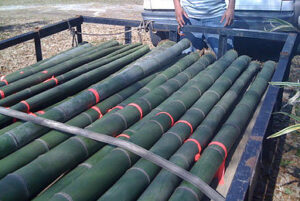
How Long Until I can Harvest Poles?
Income from the sale of poles is not likely until Year Nine. In Year Nine, you can harvest the poles that came up in Year Six.
The grove is not likely to be mature until the 10th or 12th year. A grove is mature the year that it produces full size culms. You won’t get moderate sizes until Year Six or Seven. Canes need to mature in the grove for three to five years. The larger the cane, the more years it needs to fully lignify, ie. turn into wood. So in Year Ten you will be able to harness moderate-size poles that came out of the ground in year six and seven. In Year thirteen, you can harvest the large poles that came out of the ground in year ten.
If you decide to harvest and prepare small poles for garden stakes or walking sticks, you could sell some in year Six. Black bamboo makes handsome poles and can be cut in year Six. A problem with small canes is that branches grow low on the cane. It is extra labor to remove them to make use of the canes.
You may begin thinning poles in Years Three or Four. Those small poles are useful as chips for mulch, mixing into a compost pile, or livestock bedding. Our rented six inch chipper made chips with a mixture of short and long pieces. Bamboo chips are perfect for mulching my dog yard because they bind together. They do not scatter like tree chips when the dogs travel a path.
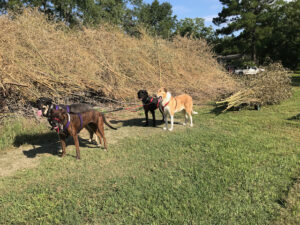 Photo with four dogs pulling poles to the pile shows one of the immense pile of poles created from thinning four year old groves. When the pile gets too tall to throw more poles on, we rent a chipper for the weekend. The dogs haul the poles on a three wheeled wagon. The front wheel is a caster from Tractor Supply. The rear wheels are the rear of a wagon.(More recently we haul the poles with pickup truck and trailer.)
Photo with four dogs pulling poles to the pile shows one of the immense pile of poles created from thinning four year old groves. When the pile gets too tall to throw more poles on, we rent a chipper for the weekend. The dogs haul the poles on a three wheeled wagon. The front wheel is a caster from Tractor Supply. The rear wheels are the rear of a wagon.(More recently we haul the poles with pickup truck and trailer.)
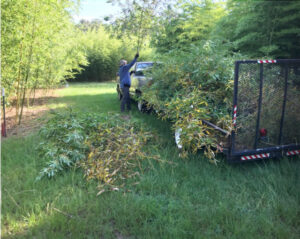 With a chipper larger than the six inch one that we rent, you get chips, instead of shreds. If the poles are aged before chipping, they are more brittle. You would get chips similar to tree chips even with a six inch chipper. Bamboo chips can be bagged and sold for mulch. Or scooped and loaded into a pickup truck.
With a chipper larger than the six inch one that we rent, you get chips, instead of shreds. If the poles are aged before chipping, they are more brittle. You would get chips similar to tree chips even with a six inch chipper. Bamboo chips can be bagged and sold for mulch. Or scooped and loaded into a pickup truck.
Make good use of thinned canes before Year Nine. Use the chips for mulch or bedding, sell them by the tractor scoop, or, bag them and sell them as bedding.
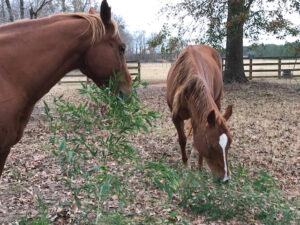
The leafy tops of bamboo could be dried and pelletized as animal feed. My guernsey calves eat fresh bamboo leaves from poles that I cut for them morning and night. Their sharp lower incisors accurately slice off each leaf leaving the twigs and branches bare. I plan to develop cattle feed from bamboo leaves and twigs with 2% added Asparagopsis taxiformis, a red seaweed. This red seaweed reduces cattle methane belching by 90%.
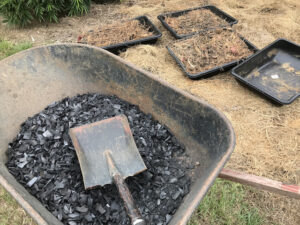 Those poles that you can’t sell? Make bamboo charcoal. Use it to improve the soil on your farm. Mix it with compost and spread it on your groves. Or develop a bamboo charcoal that you can sell.
Those poles that you can’t sell? Make bamboo charcoal. Use it to improve the soil on your farm. Mix it with compost and spread it on your groves. Or develop a bamboo charcoal that you can sell.
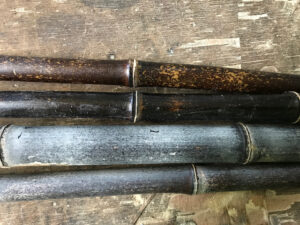 Black Bamboo may be a different story. There may be a specialty market for black poles. My favorite walking stick with my dogs is a black bamboo pole. It is light weight, strong and easy to hold.
Black Bamboo may be a different story. There may be a specialty market for black poles. My favorite walking stick with my dogs is a black bamboo pole. It is light weight, strong and easy to hold.
Black bamboo poles are green the first year out of the ground. They turn black in the second year. When you torch them, the natural oil comes out and the poles turn a rich black, or brown and tan. The photo shows two poles with a grey coating over the dark skin. The grey poles have not yet been torched. The brown and black poles have been torched so their grey coat is gone. I did not see this grey coat when I lived in Seattle. It shows up on many varieties of bamboo here in central Georgia.
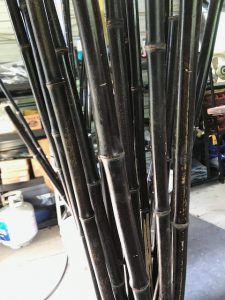
Date: May 5, 2009 11:42:33 AM PDT
To: bamboo-plantations@yahoogroups.com
Subject: Re: [bamboo-plantations] Bamboo Plantation in Camden, Alabama
Reply-To: bamboo-plantations@yahoogroups.com
I have enjoyed the recent discussion and would like to share a few experiences that might help others from making similar mistakes. My background includes several tours to China to study bamboo cultivation, production and processing. I also spent 2004-2008 studying tropical bamboo in Thailand at Kasetsart University. I own a small bamboo nursery and have been doing trials on species for processing in Texas.
As much as it hurts (you know it hurts me Richard) I must agree with Mr. Joynes. Although his use of the Socratic Method answers few questions, it raises several important concerns. While in Thailand, Mr. Joynes and I considered several products using bamboo. We found 3 problems (at least) that must first be overcome.
One: Abundance of raw materials. It requires a huge area of bamboo to supply a production facility. I personally know of a bamboo processing factory in Thailand that closed its doors, not because they were unprofitable but because they exhausted all the local sources of bamboo. The same has been the case with paper mills in India and China. On one tour in Southern China, I visited a mill that was built for the purpose of using 100% bamboo to make paper and cardboard. They now use 30% bamboo and %70 wood because there is not enough material. I found a similar experience at several other factories (charcoal and chopstick producers). The scarcity of resources is partly seasonal (no harvesting during shooting season), partly due to competition from other bamboo industries (paper is a very low value product compared to flooring, fishing poles or cutting boards) and partly due to the massive amounts required (up to 70% waste when making flooring or chopsticks). In addition, any material produced would have to be competitively priced against wood prices with the current U.S. lumber industry.
Two: Prohibitive start-up costs. The groves in China have been there for centuries so there are no start-up costs. In the U.S., however, those costs are extreme. Land that would be most suitable for bamboos is mostly used to produce higher value crops (like spinach or citrus). Any large planting would most likely occur on marginal lands that could be bought or leased for a good price ($5000/acre?). Plants useful in the U.S. would cost a minimum of $10/plant or approx. $5600/acre. Of course there are no processing factories (paper mill, flooring mill, OSB plant, particle board plant, etc.) so that would also have to be built ($800,000 – $1.5 million). Another cost prohibitive (particularly with Rayon and paper), is the environmental costs and disposal of used chemicals. In some countries, a blind eye is turned to disposal of wastes (at no expense for producers) while the expense is considerable in regulated countries.
While analyzing the possibility of starting a bamboo OSB factory several years ago, I joined a North American OSB producer’s’ organization. At the conference in Miami, I met several people interested in selling used equipment to help me get started. The minimum cost of machinery (used) would have been $1.2 million dollars and would have required a minimum of 8 full-time workers ($200,000/year minimum). I also discovered that they were selling OSB for under $4.00/sheets to large retail outlets. After running the numbers under several different scenarios, I concluded that producing bamboo OSB in the U.S. would never make it out of the red, even if the bamboo was supplied for free.
Three: Labor costs.
While Start-up costs are extreme, the largest cost would be labor. In establishing a bamboo plantation, labor during the first 3 years is extreme. Bamboo planting is done by hand. Plants must be fertilized, watered and weeded until well established. After 5 years, you have culms that are harvestable, also by hand. INBAR has a cost break-down of what it costs to bring 1 hectare into production in India (you can get all their literature if you join as an affiliate). If those figures are manipulated to reflect U.S. wages, then it becomes cheaper to buy your bamboo in India and ship them to the U.S. (Like several producers of poles currently do, i.e. www.Yucatanbamboo.com).
I do believe, however, that a plantation in Alabama (or elsewhere in the U.S.) could be very profitable if the three biggest problems can be surmounted. There must be plenty of material; products must have a very high value, and the costs must be kept to a minimum. A simple statement to make but difficult to achieve. Some possibilities are shoot production (yields >$10,000/acre), ornamental plant production ($30+/plant), pole production (local use and labor/processing at a minimum), production of an existing grove for processing at an existing paper mill (some mill changes necessary due to higher content of silica in bamboo), carbon credits in cooperation with another use (biofuels?), rehabilitate damaged land (paid-to-plant program) or other low cost/high value products. Also, bamboo would have to be the best crop for the purpose.
Whatever it is, it must capitalize on the strength of producing an item in a particular country or area which is not equaled anywhere else (i.e. China: cheap labor, large amount of bamboo, and limited costs/concerns for environmental damage; Germany: precision and exactness in production; Japan: ability to improve on ideas and reduce costs).
Please feel free to email me if you disagree or have any
questions, comments or reference requests.
Harry Simmons